 I was reading Eat Pray Love–the part where Liz Gilbert describes one of her new friends, (named Elizabeth), and I was struck by this line: “With an apartment in Rome, a house in Umbria, an Italian husband and a job that requires her to travel around Italy eating food and writing about it for Gourmet, it appears that the second Elizabeth must have saved a lot of orphans from drowning in a previous lifetime.” I guessed (correctly) that this Elizabeth had to be the wonderful writer Elizabeth Helman Minchilli. For decades my Italian travel file folders have been filled with Minchilli’s beautiful articles I’ve clipped from magazines she regularly contributes to—which include Travel & Leisure, Town & Country, Bon Appetit and Architectural Digest. You can find some of these reprinted on Elizabeth’s website, where there’s also a great blog, and if you want Rome restaurant advice from the woman who took Liz Gilbert to the best places to eat in the Eternal City, go to her Elizabeth’s Rome page.
I was reading Eat Pray Love–the part where Liz Gilbert describes one of her new friends, (named Elizabeth), and I was struck by this line: “With an apartment in Rome, a house in Umbria, an Italian husband and a job that requires her to travel around Italy eating food and writing about it for Gourmet, it appears that the second Elizabeth must have saved a lot of orphans from drowning in a previous lifetime.” I guessed (correctly) that this Elizabeth had to be the wonderful writer Elizabeth Helman Minchilli. For decades my Italian travel file folders have been filled with Minchilli’s beautiful articles I’ve clipped from magazines she regularly contributes to—which include Travel & Leisure, Town & Country, Bon Appetit and Architectural Digest. You can find some of these reprinted on Elizabeth’s website, where there’s also a great blog, and if you want Rome restaurant advice from the woman who took Liz Gilbert to the best places to eat in the Eternal City, go to her Elizabeth’s Rome page.
Elizabeth has also written six gorgeous book about Italian art and architecture,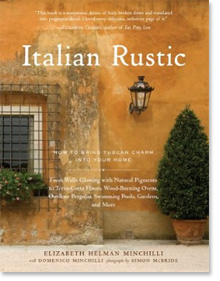 the most recent being Italian Rustic: How to Bring Italian Charm Into Your Home.
the most recent being Italian Rustic: How to Bring Italian Charm Into Your Home. 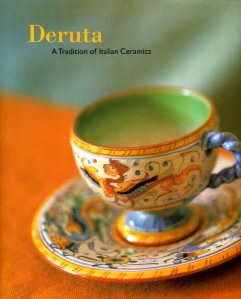 Her first book, Deruta: A Tradition of Italian Ceramics (Chronicle, 1998), was a treasured Christmas gift from my stepdaughter and has graced my coffee table for many years. So it’s a thrill now to have Elizabeth on this blog, sharing her expert advice about where to shop in this lovely Umbrian town:
Her first book, Deruta: A Tradition of Italian Ceramics (Chronicle, 1998), was a treasured Christmas gift from my stepdaughter and has graced my coffee table for many years. So it’s a thrill now to have Elizabeth on this blog, sharing her expert advice about where to shop in this lovely Umbrian town:
For those few of you who don’t know it already, Deruta is a small village in Umbria that has been producing brightly colored majolica for over six hundred years. Why does Deruta stand out over other ceramic-producing towns like Vietri and Grottaglie? The artisans of this small town have been producing high quality majolica – virtually uninterupted for six hundred years. It is this sense of history that we acquire when we bring a piece of Deruta ceramics into our home today.
Naturally a lot has changed over the years. Most of the workshops are no longer located in the picturesque town perched on the hill, but strung along the more modern Via Tiberina below. While the town thrived in the sixteenth century, Deruta’s kilns, once lit, never went out. The craftsmen that first developed the brilliant glazes in the fifteenth century passed on their knowledge and innovations in both form and patterns to future generations. One of the most attractive factors of contemporary Deruta pottery is this sense of history. 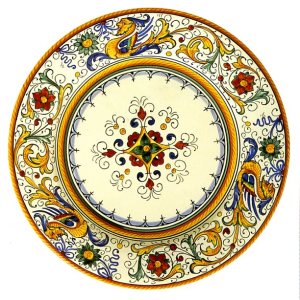 There are more than three hundred ceramic firms in Deruta today, making it one of the biggest ceramic producers in Italy.
There are more than three hundred ceramic firms in Deruta today, making it one of the biggest ceramic producers in Italy.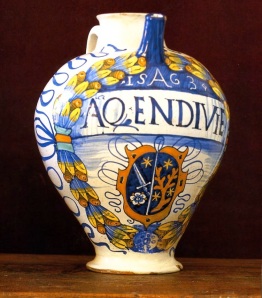 But if quantity may ring of impersonalized industrialization of a craft, the briefest of trips to Deruta dispels this view. This little town is a place where the human touch is always in evidence. The hand-crafted element conveys itself in the shapes, textures, and colors of the finished works.
But if quantity may ring of impersonalized industrialization of a craft, the briefest of trips to Deruta dispels this view. This little town is a place where the human touch is always in evidence. The hand-crafted element conveys itself in the shapes, textures, and colors of the finished works.
It is difficult to signal out specific studios to visit, but…of course I have my favorites.
Most trips to Deruta begin at the turn-of-the-century Grazia factory. Located, like all of today’s producers, on the stretch of road not far from the motorway, Grazia is the most important producer in town. Today, the Grazia factory is the only one to still work it’s own clay, from powder to the finished product and his large and airy decoration room is the training ground for many of the artisans that later strike out on their own. 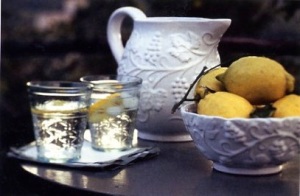 While Grazia’s repertoire includes richly colored and intricately painted patterns such as Figurina Archaico, which carry on Renaissance rhythms, my personal favorite is the pure white Uva Bianca. But be forewarned: Grazia’s prices are astronomical and the waiting list for a set of dishes is sometimes up to two years!
While Grazia’s repertoire includes richly colored and intricately painted patterns such as Figurina Archaico, which carry on Renaissance rhythms, my personal favorite is the pure white Uva Bianca. But be forewarned: Grazia’s prices are astronomical and the waiting list for a set of dishes is sometimes up to two years!
Franco Mari, down the road, has developed a unique set of patterns based only loosely on sixteenth century motives, and spiced into lively new combinations with patterns and colors seen during his travels. “Anasazi” takes American Indian sand paintings as its cue, tracing them on exquisitely formed coffee and tea sets. 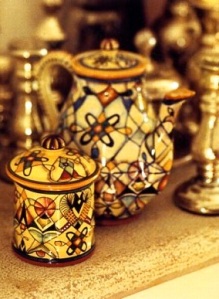 A distinguishing characteristic of Mari’s work are his glazes. They are always rich and saturated with a smoothness and brilliance, and an almost glasslike finish, that is unique to his ware. This final transparent glaze is a family secret, which Mari inherited from his father. And don’t fear if you can’t decide on a specific pattern for your dinner set: Mari encourages tableware sets where each setting features a different pattern!
A distinguishing characteristic of Mari’s work are his glazes. They are always rich and saturated with a smoothness and brilliance, and an almost glasslike finish, that is unique to his ware. This final transparent glaze is a family secret, which Mari inherited from his father. And don’t fear if you can’t decide on a specific pattern for your dinner set: Mari encourages tableware sets where each setting features a different pattern!
One of the great masters in town is Antonio Margaritelli. From the exterior, Antonio Margaritelli’s store looks like many of the other low-slung, new buildings that line the Via Tiberina. Located just past the only stoplight in town, the modern building has an intimidatingly steeply sloped parking area. But once you step through the glazed doors, the differences from the other shops around town are immediately apparent. No Gallo Verde pattern here; in fact, the first display cabinet contains a collection of objects not even for sale. Revealing his passion as well as the source of his inspiration, the most prized of Margaritelli’s enormous collection of Renaissance fragments are proudly displayed, many rivaling those on view in the museum nearby.
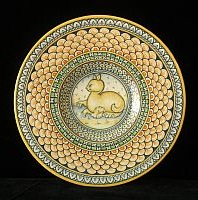 Margaritelli sets out to capture the fascination and beauty of these sixteenth century fragments. Through painstaking research and experimentation, he had rediscovered the old formulas for glazes, using pigments he digs up himself, in the surrounding hills. His exquisite production is extremely low, and he produces only a few hundred pieces per year, each one unique. All are rigorously based on antique patterns and are often hard to distinguish from the real thing. While his larger plates, meant to hang on the wall, require a substantial investment, I have started a collection of his “coppe amatorie”, or loving cups. Traditionally given to each other by lovers, these small plates bear the initial of the giver.
Margaritelli sets out to capture the fascination and beauty of these sixteenth century fragments. Through painstaking research and experimentation, he had rediscovered the old formulas for glazes, using pigments he digs up himself, in the surrounding hills. His exquisite production is extremely low, and he produces only a few hundred pieces per year, each one unique. All are rigorously based on antique patterns and are often hard to distinguish from the real thing. While his larger plates, meant to hang on the wall, require a substantial investment, I have started a collection of his “coppe amatorie”, or loving cups. Traditionally given to each other by lovers, these small plates bear the initial of the giver.
If it’s a set of mugs you want, or a brightly colored setting to use at breakfast, without worrying too much about chipping, then Sbernais your best bet. Located across the street from the more imposing Grazia, the Sberna sisters, Anna and Franca, are more than willing to help you choose from the almost overwhelming stacks of merchandise. While most of the designs are classical Deruta, they offer a refreshing array of more contemporary designs, developed by visiting designers from the United States. 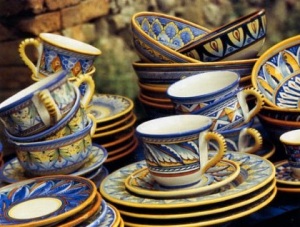 Of all the places in Deruta, this is where I come, again and again, to buy serving dishes, gifts and – as my sisters well know – complete sets of dinner plates as wedding gifts!
Of all the places in Deruta, this is where I come, again and again, to buy serving dishes, gifts and – as my sisters well know – complete sets of dinner plates as wedding gifts!
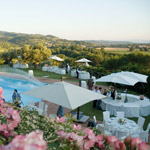 To make the Golden Day complete, head north to Torgiano, where Elizabeth recommends Le Tre Vaselle for sleeping and eating, aluxurious countryside property owned and operated by the Lungarotti family, renowned Umbrian winemakers.
To make the Golden Day complete, head north to Torgiano, where Elizabeth recommends Le Tre Vaselle for sleeping and eating, aluxurious countryside property owned and operated by the Lungarotti family, renowned Umbrian winemakers.
Grazie Elizabeth!



Thank you for the info about Elizabeth Helman. I look forward to reading her work. I loathed Eat, Pray,Love. I found most of it, particularly the Pray part nauseating. I can’t believe the interest in this awful book.
It seems nobody who reads EPL is lukewarm in their response! And even author Elizabeth Gilbert is stunned by what she calls the “freakish success” of her book.
It is strange that something can become so popular. Everybody I know was reading this book and loving it. I can’t tell you how disappointed I was when I tried to get through it. I thought it was self indulgent rubbish. I had to skip whole sections of the India bit to get through it and found the last part boring. The Italy part was only just tolerable. Different strokes for different folks.
I have Elizabeth Minchilli’s books and love them